Many software projects suffer from the clash between IT and Business departments. The day-to-day dynamics can become very frustrating. Watch this video with in English captions:
- A business user (client) requests a new feature.
- The technical team members develop the code, test it, and release it.
- The same business user or another person with the same role belittles, criticizes, and rejects the work, undermining the team’s morale.
- A servant project manager takes the hit, encourages the team, and passes the ball back to the business guys.
It’s an endless back-and-forth game. Far from seeking benefits for the organization, each of the opposing parties pursues self-protection, which can degenerate into an escalation of accusations, frustration, and unhappiness.
The name of the game is «Operation»
Let’s analyze the reasons that typically hide behind these behaviors.
- Customers usually specify the new information system need as if they know what they need, but they rarely know what they want, exactly.
- The development team doesn’t understand the business utility. They proceed without asking, making assumptions. They build the minimal code they believe satisfies the requirements to deliver as quickly as possible since they have other important tasks to attend to. The strategy of delivering quickly usually works well because business users typically don’t test the new features. When they discover the flaws, some time has passed, no one remembers the initial specification, and it’s approached as new work rather than the rework it actually is.
- If the client dedicates time to test the new feature, they discover that what has been delivered cannot be used and is incomplete. Perhaps they didn’t know what they wanted, but they certainly know what they don’t want. Feeling they’ve wasted their valuable time, they are harsh in their criticism, substantiating their arguments with business reasons that are incomprehensible to the technical team.
- The project manager defends the delivery to the client, also providing sound business reasons. They boost the team’s morale with rallying cries like, “You’ve done a fantastic job; you’re the best. The business users were wrong, we were right.”
Customers may not know how to request information systems, but they know for sue what they don’t want.
In the organization, the term “project” is used to refer to this work, but it would be more appropriate to use the designation “operation.”
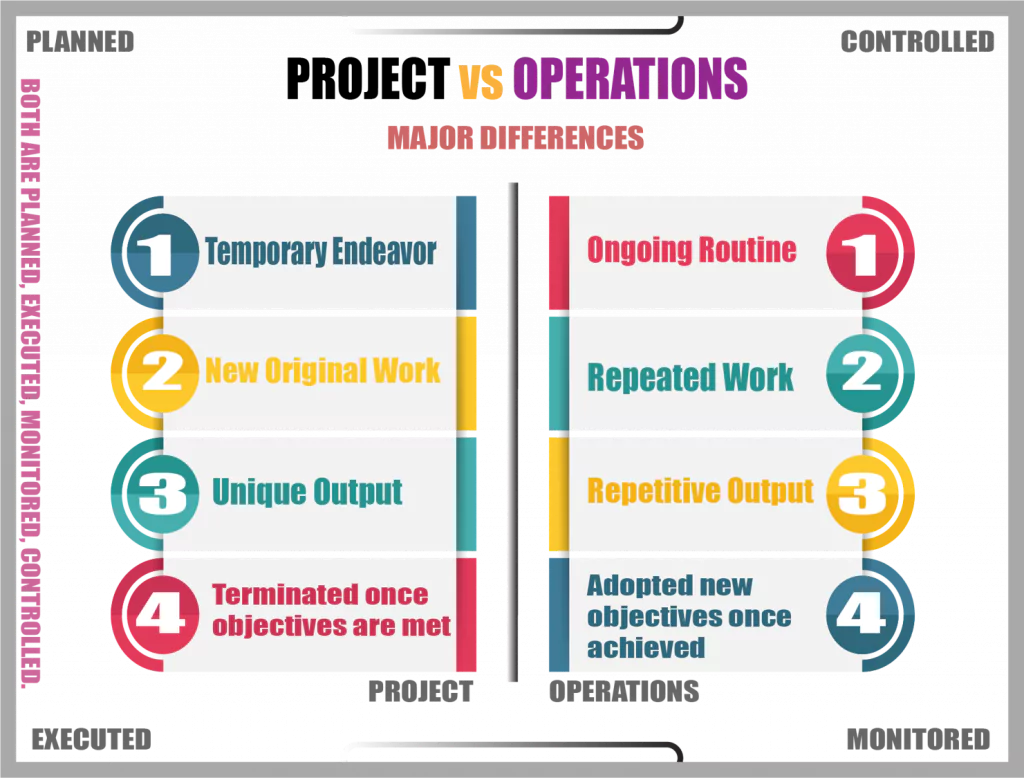
- The final product, deadlines, costs, business objectives, the closure condition, and so on, are not clear.
- Business people are partially involved, among other routine activities, dedicating only the essential time. Even the technical team is not 100% dedicated.
- The project manager acts as a task coordinator, more reactive than proactive. Until the next crisis arises, they will spend their time attending meetings, interacting via email, preparing reports, and drafting documents.
Once we understand that this way of working is called “operation” rather than a project, we could assume that by applying practices and techniques from industrial production (systematization, processes, workflows, job specialization, quality control, etc.), Business and Technology teams could collaborate effectively. Unfortunately, when it comes to software, industrialized methods are only practically effective when it’s possible to finalize the specifications in advance (e.g., mission-critical software, embedded software, foundational technology, products without screens, etc.). This is not the case with management software, where quality depends entirely on the business user’s experience, who doesn’t know what they want until they see it.
This way of working, with separate and opposing teams, lacking communication, working with partial information, making assumptions where they don’t know, trying to quickly pass the ball to the other side, etc., is unsuccessful because it is not value-oriented.
Changing the Game with Agile Projects
An effective project manager knows how to change the game, getting Business and Technology to collaborate effectively, value-oriented. They are no longer opposing teams, as if playing volleyball; now they feel like they’re all in the same boat. Requests have been discussed and understood before passing them to the technical team, and changes are welcomed if they bring more value to the business.
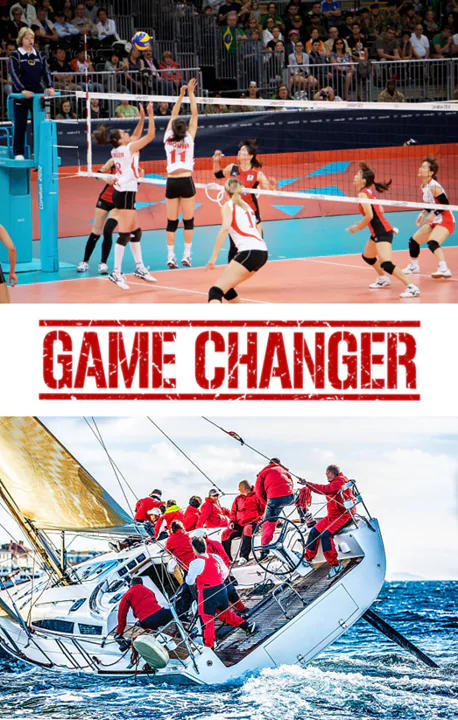
Business stakeholders, requesters, sponsors, functional managers, the PMO, etc., have someone they can ask about how the value is being delivered, when they will have access to different parts of the solution, how much it will cost, what could go wrong, etc. They can influence in a timely manner to maximize value and have confidence in their professional management to take corrective or preventive actions before it’s too late.
An effective project manager doesn’t wait for the organization to change its corporate practices or scale agility. They don’t have to wait for the team to attend courses or hire a coach. They can proactively drive the change towards value delivery from their zone of control, which is their project. According to PMI, agile project management is structured into 7 domains of practice:
Domain #1. Agile Principles and Mindset
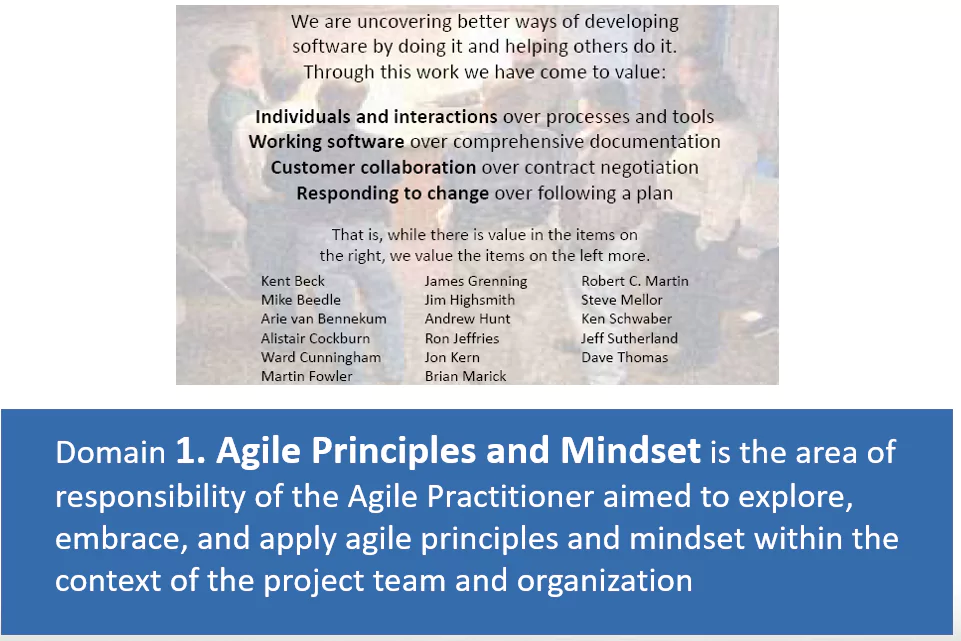
Regarding the domain #1, in their day-to-day work, project managers perform, among others, the following tasks:
- Advocate for agile principles by modeling those principles and discussing agile values in order to develop a shared mindset across the team as well as between the customer and the team.
- Help ensure that everyone has a common understanding of the values and principles of agile and a common knowledge around the agile practices and terminology being used in order to work effectively.
- Support change at the system or organization level by educating the organization and influencing processes, behaviors, and people in order to make the organization more effective and efficient.
- Practice visualization by maintaining highly visible information radiators showing real progress and real team performance in order to enhance transparency and trust.
- Contribute to a safe and trustful team environment by allowing everyone to experiment and make mistakes so that each can learn and continuously improve the way they work.
- Enhance creativity by experimenting with new techniques and process ideas in order to discover more efficient and effective ways of working.
- Encourage team members to share knowledge by collaborating and working together in order to lower risks around knowledge silos and reduce bottlenecks.
- Encourage emergent leadership within the team by establishing a safe and respectful environment in which new approaches can be tried in order to make improvements and foster self-organization and empowerment.
- Practice servant leadership by supporting and encouraging others in their endeavors so that they can perform at their highest level and continue to improve.
Domain #2. Value-Driven Delivery
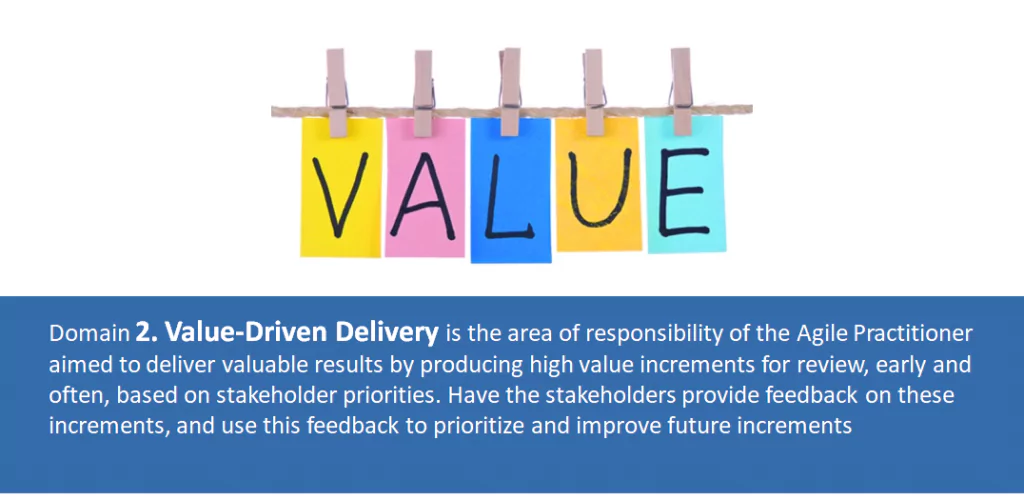
Regarding the domain #2, in their day-to-day work, project managers perform, among others, the following tasks:
- Define deliverables by identifying units that can be produced incrementally in order to maximize their value to stakeholders while minimizing non-value added work.
- Refine requirements by gaining consensus on the acceptance criteria for features on a just-in-time basis in order to deliver value.
- Select and tailor the team’s process based on project and organizational characteristics as well as team experience in order to optimize value delivery.
- Plan for small releasable increments by organizing requirements into minimally marketable features/minimally viable product in order to allow for the early recognition and delivery of value.
- Limit increment size and increase review frequency with appropriate stakeholders in order to identify and respond to risks early on and at minimal cost.
- Solicit customer and user feedback by reviewing increments often in order to confirm and enhance business value.
- Prioritize the units of work through collaboration with stakeholders in order to optimize the value of the deliverables.
- Perform frequent review and maintenance of the work results by prioritizing and maintaining internal quality in order to reduce the overall cost of incremental development.
- Continuously identify and prioritize the environmental, operational, and infrastructure factors in order to improve the quality and value of the deliverables.
- Conduct operational reviews and/or periodic checkpoints with stakeholders in order to obtain feedback and corrections to the work in progress and planned work.
- Balance development of deliverable units and risk reduction efforts by incorporating both value producing and risk reducing work into the backlog in order to maximize the total value proposition over time.
- Re-prioritize requirements periodically in order to reflect changes in the environment and stakeholder needs or preferences in order to maximize the value.
- Elicit and prioritize relevant non-functional requirements (such as operations and security) by considering the environment in which the solution will be used in order to minimize the probability of failure.
- Conduct frequent reviews of work products by performing inspections, reviews, and/or testing in order to identify and incorporate improvements into the overall process and product/service.
Domain #3. Stakeholder Engagement

Regarding the domain #3, in their day-to-day work, project managers perform, among others, the following tasks: :
- Identify and engage effective and empowered business stakeholder(s) through periodic reviews in order to ensure that the team is knowledgeable about stakeholders’ interests, needs, and expectations.
- Identify and engage all stakeholders (current and future) by promoting knowledge sharing early and throughout the project to ensure the unimpeded flow of information and value throughout the lifespan of the project.
- Establish stakeholder relationships by forming a working agreement among key stakeholders in order to promote participation and effective collaboration.
- Maintain proper stakeholder involvement by continually assessing changes in the project and organization in order to ensure new stakeholders are appropriately engaged.
- Establish collaborative behaviors among the members of the organization by fostering group decision-making and conflict resolution in order to improve decision quality and reduce the time required to make decisions.
- Establish a shared vision of the various project increments (products, deliverables, releases, iterations) by developing a high level vision and supporting objectives in order to align stakeholders’ expectations and build trust.
- Establish and maintain a shared understanding of success criteria, deliverables and acceptable trade-offs by facilitating awareness among stakeholders in order to align expectations and build trust.
- Provide transparency regarding work status by communicating team progress, work quality, impediments, and risks in order to help the primary stakeholders make informed decisions.
- Provide forecasts at a level of detail that balances the need for certainty and the benefits of adaptability in order to allow stakeholders to plan effectively.
Domain #4. Team Performance
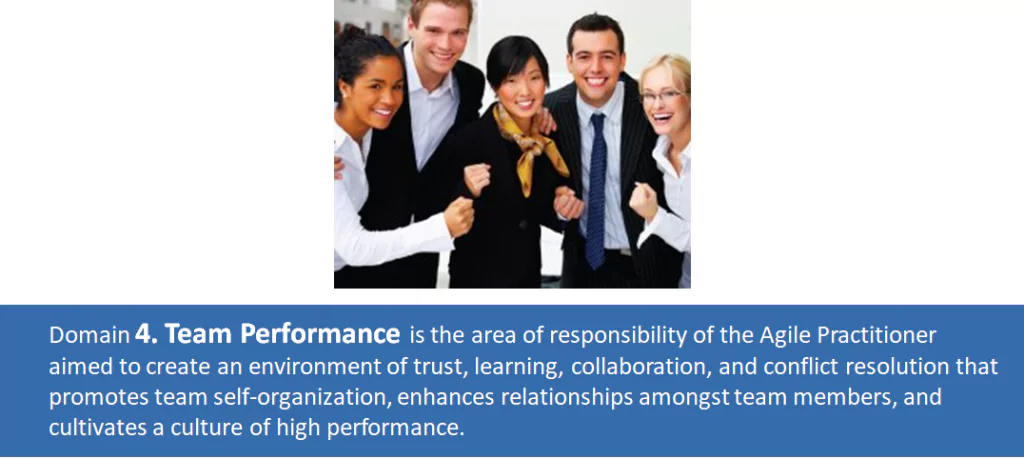
Regarding the domain #4, in their day-to-day work, project managers perform, among others, the following tasks:
- Cooperate with the other team members to devise ground rules and internal processes in order to foster team coherence and strengthen team members’ commitment to shared outcomes.
- Help create a team that has the interpersonal and technical skills needed to achieve all known project objectives in order to create business value with minimal delay.
- Encourage team members to become generalizing specialists in order to reduce team size and bottlenecks, and to create a high-performing cross-functional team.
- Contribute to self-organizing the work by empowering others and encouraging emerging leadership in order to produce effective solutions and manage complexity.
- Continuously discover team and personal motivators and de-motivators in order to ensure that team morale is high and team members are motivated and productive throughout the project.
- Facilitate close communication within the team and with appropriate external stakeholders through co-location or the use of collaboration tools in order to reduce miscommunication and rework.
- Reduce distractions in order to establish a predictable outcome and optimize the value delivered.
- Participate in aligning project and team goals by sharing project vision in order to ensure the team understands how their objectives fit into the overall goals of the project.
- Encourage the team to measure its velocity by tracking and measuring actual performance in previous iterations or releases in order for members to gain a better understanding of their capacity and create more accurate forecasts.
Domain #5. Adaptive Planning
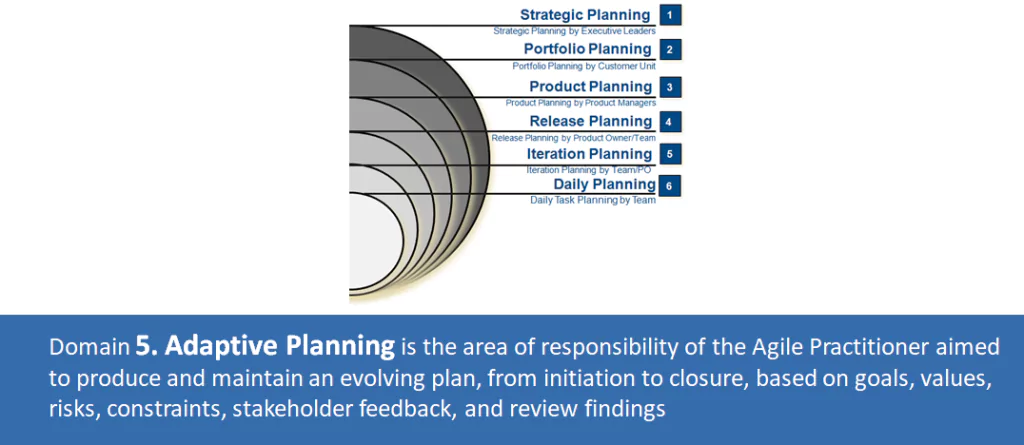
Regarding the domain #5, in their day-to-day work, project managers perform, among others, the following tasks:
- Plan at multiple levels (strategic, release, iteration, daily) creating appropriate detail by using rolling wave planning and progressive elaboration to balance predictability of outcomes with ability to exploit opportunities.
- Make planning activities visible and transparent by encouraging participation of key stakeholders and publishing planning results in order to increase commitment level and reduce uncertainty.
- As the project unfolds, set and manage stakeholder expectations by making increasingly specific levels of commitments in order to ensure common understanding of the expected deliverables.
- Adapt the cadence and the planning process based on results of periodic retrospectives about characteristics and/or the size/complexity/criticality of the project deliverables in order to maximize the value.
- Inspect and adapt the project plan to reflect changes in requirements, schedule, budget, and shifting priorities based on team learning, delivery experience, stakeholder feedback, and defects in order to maximize business value delivered.
- Size items by using progressive elaboration techniques in order to determine likely project size independent of team velocity and external variables.
- Adjust capacity by incorporating maintenance and operations demands and other factors in order to create or update the range estimate.
- Create initial scope, schedule and cost range estimates that reflect current high level understanding of the effort necessary to deliver the project in order to develop a starting point for managing the project.
- Refine scope, schedule, and cost range estimates that reflect the latest understanding of the effort necessary to deliver the project in order to manage the project.
- Continuously use data from changes in resource capacity, project size, and velocity metrics in order to evaluate the estimate to complete.
Domain #6. Problem Detection and Resolution

Regarding the domain #6, in their day-to-day work, project managers perform, among others, the following tasks:
- Create an open and safe environment by encouraging conversation and experimentation, in order to surface problems and impediments that are slowing the team down or preventing its ability to deliver value.
- Identify threats and issues by educating and engaging the team at various points in the project in order to resolve them at the appropriate time, and improve processes that caused issues.
- Ensure issues are resolved by appropriate team members and/or reset expectations in light of issues that cannot be resolved in order to maximize the value delivered.
- Maintain a visible, monitored, and prioritized list of threats and issues in order to elevate accountability, encourage action, and track ownership and resolution status.
- Communicate status of threats and issues by maintaining threat list and incorporating activities into backlog of work in order to provide transparency.
Domain #7. Continuous Improvement (Product, Process, People)
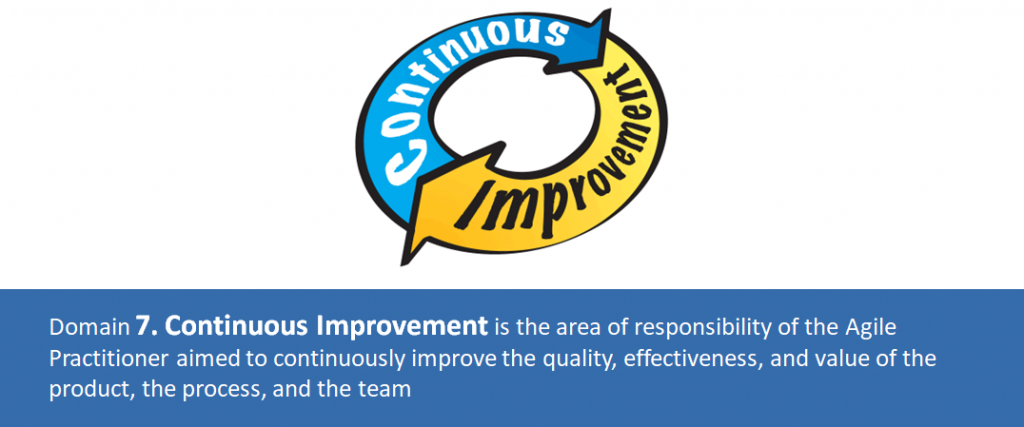
Regarding the domain #7, in their day-to-day work, project managers perform, among others, the following tasks:
- Tailor and adapt the project process by periodically reviewing and integrating team practices, organizational culture, and delivery goals in order to ensure team effectiveness within established organizational guidelines and norms.
- Improve team processes by conducting frequent retrospectives and improvement experiments in order to continually enhance the effectiveness of the team, project, and organization.
- Seek feedback on the product by incremental delivery and frequent demonstrations in order to improve the value of the product.
- Create an environment of continued learning by providing opportunities for people to develop their skills in order to develop a more productive team of generalizing specialists.
- Challenge existing process elements by performing a value stream analysis and removing waste in order to increase individual efficiency and team effectiveness.
- Create systemic improvements by disseminating knowledge and practices across projects and organizational boundaries in order to avoid re-occurrence of identified problems and improve the effectiveness of the organization as a whole.
Agile Project Life Cycle
The lifecycle of an agile project could be summarized as described below:
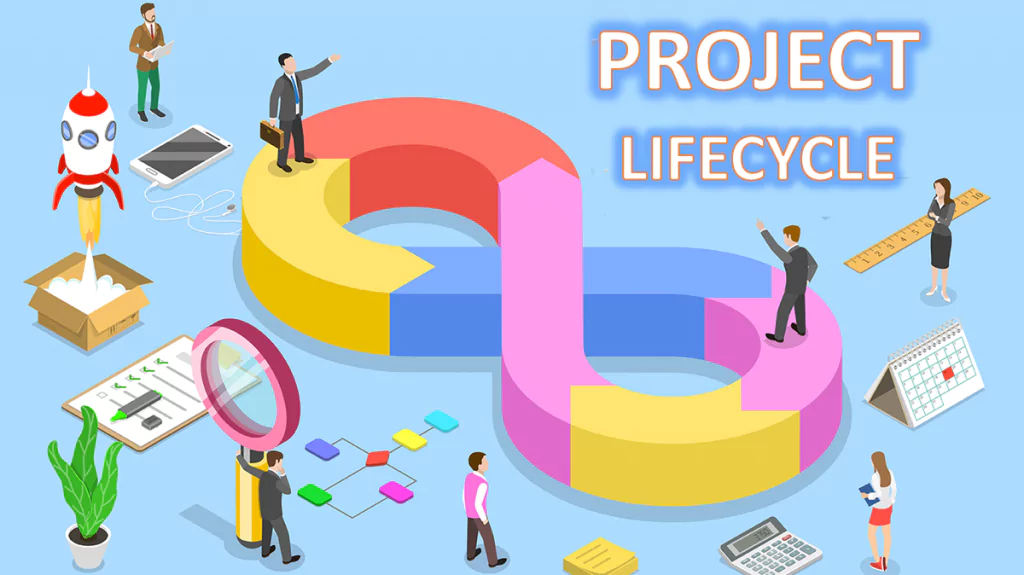
- Initiation: The new functionality might be a specific task that doesn’t warrant managing as a project, but more often than not, it’s part of a larger business need. The project manager can facilitate the project’s initiation phase, during which business stakeholders reach high-level agreements on what needs to be done, why, when, how, etc. The project’s priority is reasonably justified, and a sponsor, often a manager, authorizes its execution.
- Planning: With the help of business stakeholders, the project manager organizes the different deliveries of the project, prioritizing the most critical aspects first and leaving less valuable elements for later deliveries. They create a roadmap that aligns with the business-required milestones, showing when the deliveries will be available, typically between 3 and 5. Starting from the conclusion of the first delivery, those involved can already use some highly valuable functionalities. Each delivery is modeled as a project phase, divided into iterations of equal duration (typically 2 weeks), usually between 5 and 10 iterations per delivery. This approach is called gradual planning because, as the project progresses, more detailed scope elements are discovered. From the first delivery, the subsequent high-level functionalities are replanned. From the first iteration, detailed functionalities are refined.
- Execution: The project manager promotes an “agile mindset,” avoiding the separation between Business and Technology. Both business representatives and development team members should understand that they are part of the same team, albeit with different roles. Business representatives help progressively clarify functional details, assist in resolving impediments quickly, attend demonstrations, confirm or reject (without drama) increments, feel encouraged to request welcomed changes, etc. On the other hand, the technical team self-organizes to achieve excellence, is not disturbed during the iteration, understands the functionality because they themselves conduct demonstrations at the end of each iteration, etc. The project manager doesn’t invent this way of working. Frameworks like Scrum, which have been around for over 25 years, provide specific guidance on what needs to be done and are easy to understand for all stakeholders (easy to understand doesn’t mean it’s easy to practice well). At the end of each iteration, there is a validated product increment. Iterations continue until the delivery’s functionality is completed. Then, it goes into production, and users can use the most critical features. Next, work begins on the next delivery. Value is delivered gradually.
- Closure: After the last delivery has gone into production, if business representatives confirm that value has been delivered and needs have been met, the project manager proceeds with the formal closure of the project, following the organization’s processes.
Agile Projects in PMPeople
PMPeople is the tool for the Project Economy. All types of organizations manage projects, programs, and portfolios to turn ideas into reality. Organizations are getting “projectified” and need project professionals to ensure predictability, accountability, and final success of each project.
The project justification can be documented in an agile manner in the initiation tab, where personas can also be detailed. In the planning tab, epics can be associated as requirements or tasks in the zero package. The project can be broken down into its different sequential deliveries, detailing their respective features as requirements or tasks within the corresponding work package. Technical team members can collaboratively create a team charter and note the topics they want to address in the next retrospective on the happiness index. If the team decides to use an agile tool to manage stories, tasks, virtual boards, backlogs, etc., such as Asana, the project manager can track details directly there, although they can connect high-level tasks (epics, functionalities, etc.) to synchronize them in the corresponding work package. In many cases, team members only use PMPeople to track hours and expenses.
PMPeople is a technology for project professionals to collaborate using roles. Launched in April 2018 for PMOs and project professionals using 12 collaborative roles to work in teams professionally, in the cloud, collaborating on projects, programs and portfolios.
PMPeople goes beyond simply following workflows, chains of supervision, processes, or document templates: it promotes people interact as individuals. Project Managers can manage projects at many organizations using predictive and agile frameworks. Stakeholders can supervise many projects and give feedback with their mobile application. Team members can know their teammates and job descriptions, submit comments, timesheets, expenses, etc.
PMPeople is aimed to unify professional project management by these differential points:
- Designed by and for professional project managers, following professional project management standards.
- Online productivity –less meetings, less documents, less workflows– through distributed collaboration among 12 specialized roles: Organization Owner, 6 roles on demand management and 5 roles on supply management.
- Freemium product –unlimited time, unlimited users– usable via web and mobile application.
Start using PMPeople for free, for unlimited time and for any number of users. In premium organizations, only managers have a cost. Several roles –stakeholders, team members, sponsors, and resource managers– are always free. You can increase or decrease your premium seats according to the organization’s actual needs. Premium organizations have access to our online interactive support. Our servers are located in the EU. This software can also be hosted on customer premises.
Jose Barato
Related posts
Categories
- Business (16)
- Demand Management Roles (14)
- Frequently Asked Questions (7)
- Guide (26)
- People (23)
- Assignments (2)
- Feedback (2)
- Project Team (3)
- Tracking Time And Expenses (2)
- Process (9)
- Closing (2)
- Executing And Controlling (2)
- Planning (1)
- Project Management (67)
- Management Frameworks (18)
- Organization Owner (OO) (3)
- Project Economy (54)
- Tools (19)
- Supply Management Roles (5)
- Training (6)
- Uncategorized (1)





